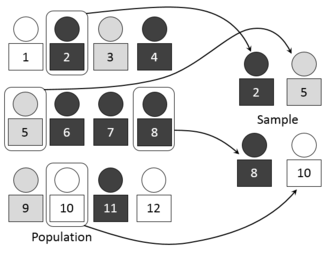Sampling (statistics)





Sampling (statistics) is a process used in statistics for selecting a subset of individuals, items, or data from within a statistical population to estimate characteristics of the whole population. Statisticians use various sampling methods to reduce the cost and/or the amount of data that needs to be collected by focusing on only a part of the population. The aim is to obtain a sample that is representative of the population, so that conclusions can be drawn about the population from the sample.
Types of Sampling Methods[edit]
There are two broad categories of sampling methods: Probability sampling and Non-probability sampling.
Probability Sampling[edit]
In probability sampling, every member of the population has a known, non-zero chance of being selected. Types of probability sampling include:
- Simple Random Sampling: Every member of the population has an equal chance of being selected.
- Stratified Sampling: The population is divided into strata, and random samples are taken from each stratum.
- Cluster Sampling: The population is divided into clusters, and a random sample of these clusters is selected.
- Systematic Sampling: Every nth member of the population is selected.
Non-probability Sampling[edit]
In non-probability sampling, not every member of the population has a chance of being selected. Types include:
- Convenience Sampling: Samples are taken from a group that is conveniently accessible.
- Judgment Sampling: The researcher uses their judgment to select members of the population that they think are most representative.
- Quota Sampling: The researcher ensures that certain characteristics are represented in the sample to a certain extent.
- Snowball Sampling: Existing study subjects recruit future subjects from among their acquaintances.
Sampling Error[edit]
Sampling error occurs when the sample does not perfectly represent the population. It is the difference between the sample statistic and the actual population parameter. Sampling error can be reduced by increasing the sample size and using a more representative sampling method.
Importance of Sampling[edit]
Sampling is crucial in statistics because it allows researchers to obtain information about a population without having to investigate every individual. This makes research more feasible in terms of time, cost, and effort. Sampling is widely used in various fields such as market research, opinion polling, and clinical trials.
Challenges in Sampling[edit]
Challenges in sampling include ensuring that the sample is representative of the population, dealing with non-response, and minimizing sampling error. Proper planning, understanding the population, and selecting the appropriate sampling method are essential to address these challenges.
| This article is a stub. You can help WikiMD by registering to expand it. |
Ad. Transform your life with W8MD's Budget GLP-1 injections from $75


W8MD offers a medical weight loss program to lose weight in Philadelphia. Our physician-supervised medical weight loss provides:
- Weight loss injections in NYC (generic and brand names):
- Zepbound / Mounjaro, Wegovy / Ozempic, Saxenda
- Most insurances accepted or discounted self-pay rates. We will obtain insurance prior authorizations if needed.
- Generic GLP1 weight loss injections from $75 for the starting dose.
- Also offer prescription weight loss medications including Phentermine, Qsymia, Diethylpropion, Contrave etc.
NYC weight loss doctor appointmentsNYC weight loss doctor appointments
Start your NYC weight loss journey today at our NYC medical weight loss and Philadelphia medical weight loss clinics.
- Call 718-946-5500 to lose weight in NYC or for medical weight loss in Philadelphia 215-676-2334.
- Tags:NYC medical weight loss, Philadelphia lose weight Zepbound NYC, Budget GLP1 weight loss injections, Wegovy Philadelphia, Wegovy NYC, Philadelphia medical weight loss, Brookly weight loss and Wegovy NYC
|
WikiMD's Wellness Encyclopedia |
| Let Food Be Thy Medicine Medicine Thy Food - Hippocrates |
Medical Disclaimer: WikiMD is not a substitute for professional medical advice. The information on WikiMD is provided as an information resource only, may be incorrect, outdated or misleading, and is not to be used or relied on for any diagnostic or treatment purposes. Please consult your health care provider before making any healthcare decisions or for guidance about a specific medical condition. WikiMD expressly disclaims responsibility, and shall have no liability, for any damages, loss, injury, or liability whatsoever suffered as a result of your reliance on the information contained in this site. By visiting this site you agree to the foregoing terms and conditions, which may from time to time be changed or supplemented by WikiMD. If you do not agree to the foregoing terms and conditions, you should not enter or use this site. See full disclaimer.
Credits:Most images are courtesy of Wikimedia commons, and templates, categories Wikipedia, licensed under CC BY SA or similar.
Translate this page: - East Asian
中文,
日本,
한국어,
South Asian
हिन्दी,
தமிழ்,
తెలుగు,
Urdu,
ಕನ್ನಡ,
Southeast Asian
Indonesian,
Vietnamese,
Thai,
မြန်မာဘာသာ,
বাংলা
European
español,
Deutsch,
français,
Greek,
português do Brasil,
polski,
română,
русский,
Nederlands,
norsk,
svenska,
suomi,
Italian
Middle Eastern & African
عربى,
Turkish,
Persian,
Hebrew,
Afrikaans,
isiZulu,
Kiswahili,
Other
Bulgarian,
Hungarian,
Czech,
Swedish,
മലയാളം,
मराठी,
ਪੰਜਾਬੀ,
ગુજરાતી,
Portuguese,
Ukrainian